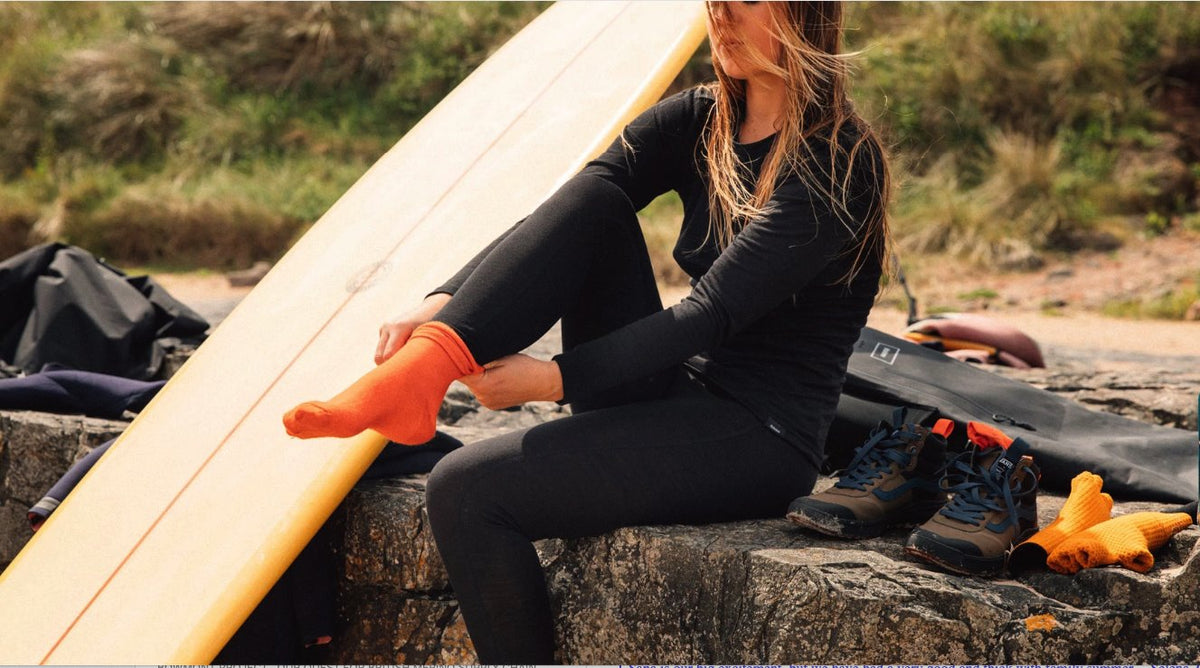Why merino base layers are your year round wardrobe must-have

Struggling with the transition between seasons? You need a merino base layer. Simple as that. It’s a year round wardrobe staple that smart stylists add to their layering advice. And we have the heralded merino sheep to thank for their extra clever coats.
What exactly is a merino sheep?
Marvellous merino are beautiful, hardy beasts that can survive temperature extremes. They’ve been bred all over the world because of their ability to thrive in climates from -10 degrees C to +30 degrees C. They are bred largely in Australia and New Zealand where they have to survive scorchio summers with cold nights as well as icy winters. Their fleece is soft as silk, lightweight and breathable. With one notable exception they don't thrive in the British Isles because of the high levels of rain here.
They invented layering
Want to know how this incredible animal thrives in temperature extremes? They are the experts in layering! These sheep grow an extra layer of wool over their natural ‘base layer’ to give them extra protection when the mercury drops into minus figures.
Merino base layer for humans
As expounded by our friends over at Finisterre, a merino base layer sits snugly against your skin. It’s the new vest, made modern with a traditional material. It traps a layer of warm air against your skin, much like a wetsuit traps a layer of warm water against your body to keep you comfortable in cold seas.
The colder it is, the more layers you’ll need. Each layer will add another ‘blanket’ of warm air around your body to keep it toasty, whatever the elements throw at you. Another huge benefit of layering is that you can adjust them to suit as the day and your activity levels go on.
Soft on skin
This is superfine wool and that’s important in base layers. Why? Because merino fibres are one quarter as thick as a human hair, and half the thickness of lambswool fibres, it is very supple. A merino base layer flexes away from your skin, so it isn’t prickly or itchy. It doesn't irritate. And when something is that close to you all day, that’s essential.
Warm or cool
There’s no synthetic (read: chemical imitation of something real) fibre on earth that can regulate your temperature the way all-natural merino can. When you’re out in the hills, on your bike, or racing around on the school run, you’re going to sweat. Your body produces beads of moisture on your skin to cool you down. Merino fibres carry moisture away from the skin by sucking up the vapour you produce into the tiny plates that the fibres are made up of.
Synthetic alternatives only wick sweat once it has become a liquid, and your body has heated up enough to evaporate it. At the end of play, wearing synthetic materials, these sweat droplets will quickly turn cold, leaving you clammy and shivering. Wearing merino, you’ll stay dry during your exertion and remain warm when it’s over.
Merino activewear
Outdoor enthusiasts know that there’s no such thing as bad weather, only the wrong clothing. Keeping warm on the slopes or in the hills is a breeze with a merino base layer as part of your activewear. The natural ‘crimps’ in each fibre trap a layer of air bubbles by your skin. It’s like a warm air blanket that will help you stay out on the slopes for longer and wearing a bigger smile, too.
It’s also light and compact in comparison to sheep’s wool so just the job for travelling with or in, or overnight treks where you’ll have limited packing space.
Sweat without the smell
Let’s be honest, not many of us are fragrant when we perspire, and there’s a scientific reason why. When you sweat, your body releases fats and salts that are a smorgasbord for bacteria. They feast on the stuff, and they smell. Bad.
Merino base layers, like all natural wools, contain natural anti-microbial properties that inhibit the growth of bacteria, even after being used many times. No bacteria = no nasty whiffs. In fact, one runner recently wore the same merino base layer for three months without washing to prove that merino is the perfect base layer. He describes it here (beware the swears).
Sustainable merino
Here’s another bonus of wearing a merino base layer. You won’t have to wash it as much. Because it smells less and stays fresher for longer, you won’t have to wash it as often. So it will give you a few extra year’s loyal service, too. Less washing, less waste, less environmental damage. We like!
Dress for (the planet’s) success
Despite continued wearing, because merino wool of the double helix at the core of the fibre, it springs back into shape after long wear or washing. Your favourite merino base layer won’t suffer saggy elbows!
If you decided to bury your merino base layer, in 10 years it would be totally broken down and reabsorbed back into the soil. If you don’t actually want clothes that last forever, isn’t it awesome that your old merino clothes will one day replenish the ecosystem, releasing the carbon and nutrients of this fibrous protein back into the earth. Merino is a naturally grown, renewable fibre.
Final word of advice
Whatever you do, don’t dig out your old cotton vest. Cotton soaks up sweat, draws warmth away from your body and leaves you in a cold sweat.
If you have any questions about why merino wool is so wonderful, please drop us a line, any time.
Image courtesy of Finisterre.com